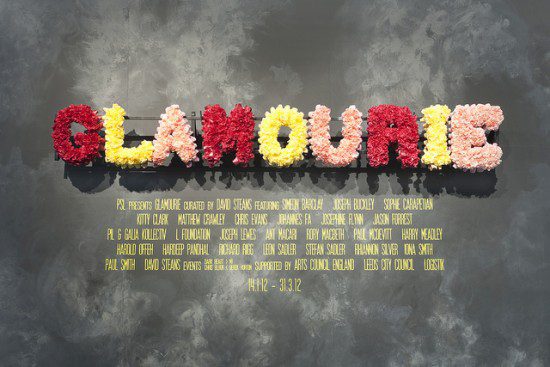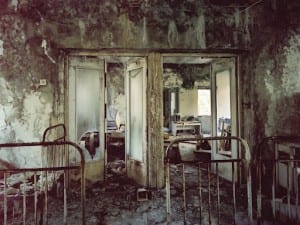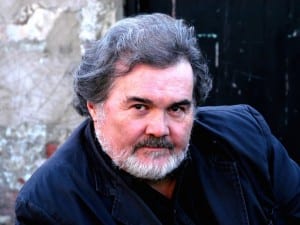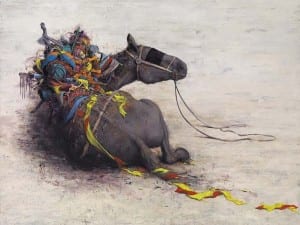Text by Elizabeth Holdsworth
An immobile red hatchback, front smashed against a skewed road sign, blares out hypnotic and maniacal club anthems from its boasting stereo system. Beyond, bagpipes coalesce with distant explosions, and someone, somewhere, is cranking a hurdy-gurdy.
This is the distinctive sound of Glamourie, the current exhibition at Project Space Leeds so named after Celtic lore, a magic transformation from “the normal aspect of an object or area… [into its] resplendent… semblance.” Upon this fluid basis, the exhibition voyages upon exploring the idea of a glamourie and itself becoming one. Project Space Leeds’ expanse of divisible spaces becomes the ground for the figuration of a holistic approach to curating, where artworks are both nestled and spliced together in the pursuit of an altered and distinct whole.
Once through the project space’s glass exterior, the visitor is greeted with a relentless cacophony and visual conundrum. Like opening a loaded and secret drawer, the show tumbles and spills unrestrained into the spaces like an overflowing toy box. Artworks overlap and buttress each other unashamedly and without classification. Each contained area of the space is categorized by a symbol on the wall, so that, if examining the accompanying leaflet closely and deciphering the materials of the works, visitors can just about decipher which work is by which artist. A deliberate move towards shaping Glamourie as a whole and single entity, artist-curator David Steans makes no apologies for this esoteric gesture: “there is no interpretation, you have to take everything in at once”, he explains during a gallery walk-round.
Above the gallery reception desk the exhibition’s title is rendered in funereal floral lettering in pink, yellow and maroon. The floral letters, titled Service for a Vacant Coffin, form both branding of the show and an artwork by Steans, setting the climate and distinguishing Glamourie as not something dead, but something uncanny revelling in the ghoulish, lurid and uncouth. Although Steans claims the exhibition to not be an artwork itself, the curating of it was undoubtedly approached as an artistic endeavour and it becomes tempting to make that conceptual step.
Leading us into the largest area of the gallery space, a long, low banqueting table in MDF stretches through the space, places set with a single Bristol blue glass bowl, one for each artist in the exhibition. In contrast, aside the table is a demarcated cell, closed off from the rest of the space by a newly installed partition wall. To enter this area the visitor must climb through a hole in the shape of Michelangelo’s The Creation of Adam, into a white box with black geometric shapes painted on all sides of the walls and floor, like entering a surreal electronic hallucination. This space exclusively contains the work of Ant Macari, a contrasting arrangement to the rest of Glamourie: an amazing space, yet incongruous to the the rest of the exhibition. Like a self-contained solo show within Glamourie, Macari’s work shrugs off interaction with the group and refuses to join the feasting.
In gestures which deface and dress the PSL galleries, works by Joseph Buckley and Harry Meadley both point to the limitations of the neutrality of the space. Buckley’s giant gaffer tape crosses fill every pane of glass on the front of PSL, so that the gallery may well appear abandoned to a passerby or commuter on the adjacent Leeds to London railway line. As light pours through the windows the X’s strike through everything, effacing all in its path. Shadows with no shadow (that thin black line)(2012), Harry Meadley’s black electrical tape, creates a fake shadow line along the base of the galleries’ walls, an aggrandising or perhaps gentle mocking of the roughness of a project space. Near the entrance, forming an area easily mistaken for the gallery’s cafe seating, Oakwood Gallery 3 by Matthew Crawley is a replica of the front of a Spanish Tapas restaurant: a large backlit sign mounted on the wall flanked by hanging baskets of plastic flowers, hovering over lightweight metal tables and chairs. Eclipsing the entry spaces of PSL, Crawley implants a playful new façade which serves us the rest of the show: all art as tapas.
Glamourie is an exhibition curated by an artist, of his fellow artists, predominantly for other artists. The blue bowl banqueting table, Iona Smith’s Super Supra – Glamour toasting rite feat. David Steans (Tameda) illustrates this sense of camaraderie to great effect, as it becomes apparent that the table top is resting on and supported by the benches along each side, so in order to function the table would need to rest on the laps of each of the artists in the exhibition. Indicating the possible endangerment of its kind, this network of artists arises out of connections forged amid a UK art school system currently being dismantled. Visitors attending Glamourie hooked in by themes of ritual and ceremony and expecting immediate recompense will most likely be at a loss, as this clandestine company of artists, with a loud, ugly collection of intriguing works, is not one to be easily untangled or resolved.
Aesthetica in Print
If you only read Aesthetica online, you’re missing out. The February/March issue of Aesthetica is out now and offers a diverse range of features from an examination of the diversity and complexity of art produced during the tumultuous decade of the 1980s in Art, Love & Politics in the 1980s, opening 11 February at MCA Chiacgo, a photographic presentation of the Irish Museum of Modern Art‘s latest opening, Conversations: Photography from the Bank of America Collection. Plus, we recount the story of British design in relation to a comprehensive exhibition opening this spring at the V&A.
If you would like to buy this issue, you can search for your nearest stockist here. Better yet call +44 (0) 1904 629 137 or visit the website to subscribe to Aesthetica for a year and save 20% on the printed magazine.
Glamourie, 14/01/2012 – 31/03/2012, Whitehall Waterfront, 2 Riverside Way, Leeds, LS1 4EH. www.projectspaceleeds.org.uk www.glamourie.co.uk
Caption:
1. David Steans Service for a Vacant Coffin
2. Iona Smith, Leon Sadler and Ant Macari
3. Sophie Carapetian, Joseph Buckley and L Foundation
4. David Steans, Kitty Clark, Harry Meadley, Chris Evans, Paul Mc Devitt and Rory Macbeth
All images courtesy of Project Space Leeds
Photography: Ben Statham





